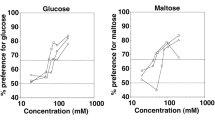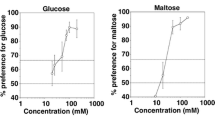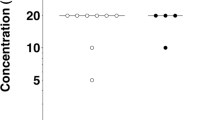Abstract
We aimed to determine taste preference thresholds for 5 food-associated sugars in Papio hamadryas anubis. In a 2-bottle preference test of brief duration (2 min) 4 subadult baboons significantly preferred concentrations as low as 10 mM sucrose, 20 mM fructose, lactose, and maltose, and 25 mM glucose over tap water. Presentation of suprathreshold sugar solutions led to marked concentration-dependent polydipsia. The results show that baboons are among the most sugar-sensitive nonhuman primates tested so far and, thus, support the assumption that Papio hamadryas anubis may use sweetness as a criterion for food selection.
Similar content being viewed by others
REFERENCES
Aldrich-Blake, F. P. G., Bunn, T. K., Dunbar, R. I. M., and Headley, P. M. (1971). Observations on baboons, Papio anubis, in an arid region in Ethiopia. Folia Primatol. 15: 1-35.
Altmann, S. A., and Altmann, J. (1970). Water and food. In Altmann, S. A., and Altmann, J. (eds.), Baboon Ecology—African Field Research, Karger, Basel, pp. 136-169.
American Society for Testing and Materials (1973). Compilation of odor and taste threshold values data, ASTM Data Series DS 48, Philadelphia.
Barton, R. A., Whiten, A., Byrne, R. W., and English, M. (1993). Chemical composition of baboon plant foods: Implications for the interpretation of intra-and interspecific differences in diet. Folia Primatol. 61: 1-20.
Bonnaire, L., and Simmen, B. (1994). Taste perception of fructose solutions and diet in Lemuride. Folia Primatol. 63: 171-176.
Dennys, V., and Hladik, C. M. (1988). Le seuil de préférence du saccharose chez les prosimiens de Madagascar et son implication dans le comportement alimentaire. Biol. Behav. 13: 43-48.
Dilley, D. R. (1970). Enzymes. In Hulme, A. C. (ed.), The Biochemistry of Fruits and Their Products, Vol. I, Academic Press, New York, pp. 179-207.
Feigin, M. B., Sclafani, A., and Sunday, S. R. (1987). Species differences in polysaccharide and sugar taste preferences. Neurosci. Biobehav. Rev. 11: 231-240.
Glaser, D. (1986). Geschmacksforschung bei Primaten. Vjschr. Naturforsch. Ges. Zurich 131: 92-110.
Glaser, D., Tinti, J. M., and Nofre, C. (1995). Evolution of the sweetness receptor in primates. I. Why does alitame taste sweet in all prosimians and simians, and aspartame only in Old World simians? Chem. Senses 20: 573-584.
Harder, D. B., Maggio, J. C., and Whitney, G. (1989). Assessing gustatory detection capabilities using preference procedures. Chem. Senses 14: 547-564.
Hellekant, G., Glaser, D., Brouwer, J., and van der Wel, H. (1981). Gustatory responses in three prosimian and two simian species to six sweeteners and miraculin and their phylogenetic implications. Chem. Senses 6: 165-173.
Hladik, C. M., and Simmen, B. (1996). Taste perception and feeding behavior in nonhuman primates and human populations. Evol. Anthropol. 5: 58-71.
Jenness, R., and Sloan, R. E. (1970). The composition of milks of various species. A review. Dairy Sci. Abstr. 32: 599-612.
Kinghorn, A. D., and Soejarto, D. D. (1986). Sweetening agents of plant origin. CRC Crit. Rev. Plant Sci. 4: 79-120.
Laska, M. (1994). Taste intensity difference thresholds for sucrose in squirrel monkeys (Saimiri sciureus). Folia Primatol. 63: 144-148.
Laska, M. (1996). Taste preference thresholds for food-associated sugars in the squirrel monkey, Saimiri sciureus. Primates 37: 91-95.
Laska, M. (1997). Taste preferences for five food-associated sugars in the squirrel monkey (Saimiri sciureus). J. Chem. Ecol. 23: 659-672.
Laska, M., Carrera Sanchez, E., and Rodriguez Luna, E. (1996). Gustatory thresholds for food-associated sugars in the spider monkey (Ateles geoffroyi). Am. J. Primatol. 39: 189-193.
Laska, M., Carrera Sanchez, E., and Rodriguez Luna, E. (1998). Relative taste preferences for food-associated sugars in the spider monkey (Ateles geoffroyi). Primates 39: 91-96.
Nagy, S., and Shaw, P. E. (1980). Tropical and Subtropical Fruits: Composition, Nutritive Values, Properties and Uses, Avi, Westport, CT.
Nofre, C., Tinti, J. M., and Glaser, D. (1996). Evolution of the sweetness receptor in primates. II. Gustatory responses of non-human primates to nine compounds known to be sweet in man. Chem. Senses 21: 747-762.
Norton, G. W., Rhine, R. J., Wynn, G. W., and Wynn, R. D. (1987). Baboon diet: A five-year study of stability and variability in the plant feeding and habitat of the yellow baboon (Papio cynocephalus) of Mikumi National Park, Tanzania. Folia Primatol. 48: 78-120.
Oftedal, O. T., and Iverson, S. J. (1995). Comparative analysis of milk. A Phylogenetic variation in the gross composition of milk. In Jensen, R. G. (ed.), Handbook of Milk Composition, Academic Press, San Diego, pp. 749-787.
Pfaffman, C. (1977). Biological and behavioral substrates of the sweet tooth. In Weiffenbach, J. M. (ed.), Taste and Development. The genesis of sweet preference, U.S. Government Print Office, Washington, DC, pp. 3-24.
Pfaffman, C., and Bartoshuk, L. M. (1971). Taste psychophysics. In Beidler, L. M. (ed.), Handbook of Sensory Physiology, Vol. 4, Part 2, Springer-Verlag, Berlin, pp. 75-101.
Post, D. G. (1982). Feeding behavior of yellow baboons (Papio cynocephalus) in the Amboseli National Park, Kenya. Int. J. Primatol. 3: 403-430.
Post, D. G., Hausfater, G., and McCuskey, S. A. (1980). Feeding behavior of yellow baboons (Papio cynocephalus): Relationship to age, gender and dominance rank. Folia Primatol. 34: 170-195.
Reilly, S., Norgren, R., and Pritchard, T. C. (1994). A new gustometer for testing taste discrimination in the monkey. Physiol. Behav. 55: 401-406.
Ross, C. (1992). Basal metabolic rate, body weight and diet in primates: An evaluation of the evidence. Folia Primatol. 58: 7-23.
Sclafani, A., and Mann, S. (1987). Carbohydrate taste preferences in rats: Glucose, sucrose, maltose, fructose and polycose compared. Physiol. Behav. 40: 563-568.
Siegel, S., and Castellan, N. J. (1988). Nonparametric Statistics for the Behavioral Sciences. McGraw-Hill, New York.
Simmen, B. (1994). Taste discrimination and diet differentiation among New World primates. In Chivers, D. J., and Langer, P. (eds.), The Digestive System in Mammals: Food, Form and Function, Cambridge University Press, Cambridge, pp. 150-165.
Whiting, G. C. (1970). Sugars. In Hulme, A. C. (ed.), The Biochemistry of Fruits and Their Products, Vol. I, Academic Press, New York, pp. 1-31.
Author information
Authors and Affiliations
Rights and permissions
About this article
Cite this article
Laska, M., Schüll, E. & Scheuber, HP. Taste Preference Thresholds for Food-Associated Sugars in Baboons (Papio hamadryas anubis). International Journal of Primatology 20, 25–34 (1999). https://doi.org/10.1023/A:1020580132667
Issue Date:
DOI: https://doi.org/10.1023/A:1020580132667




